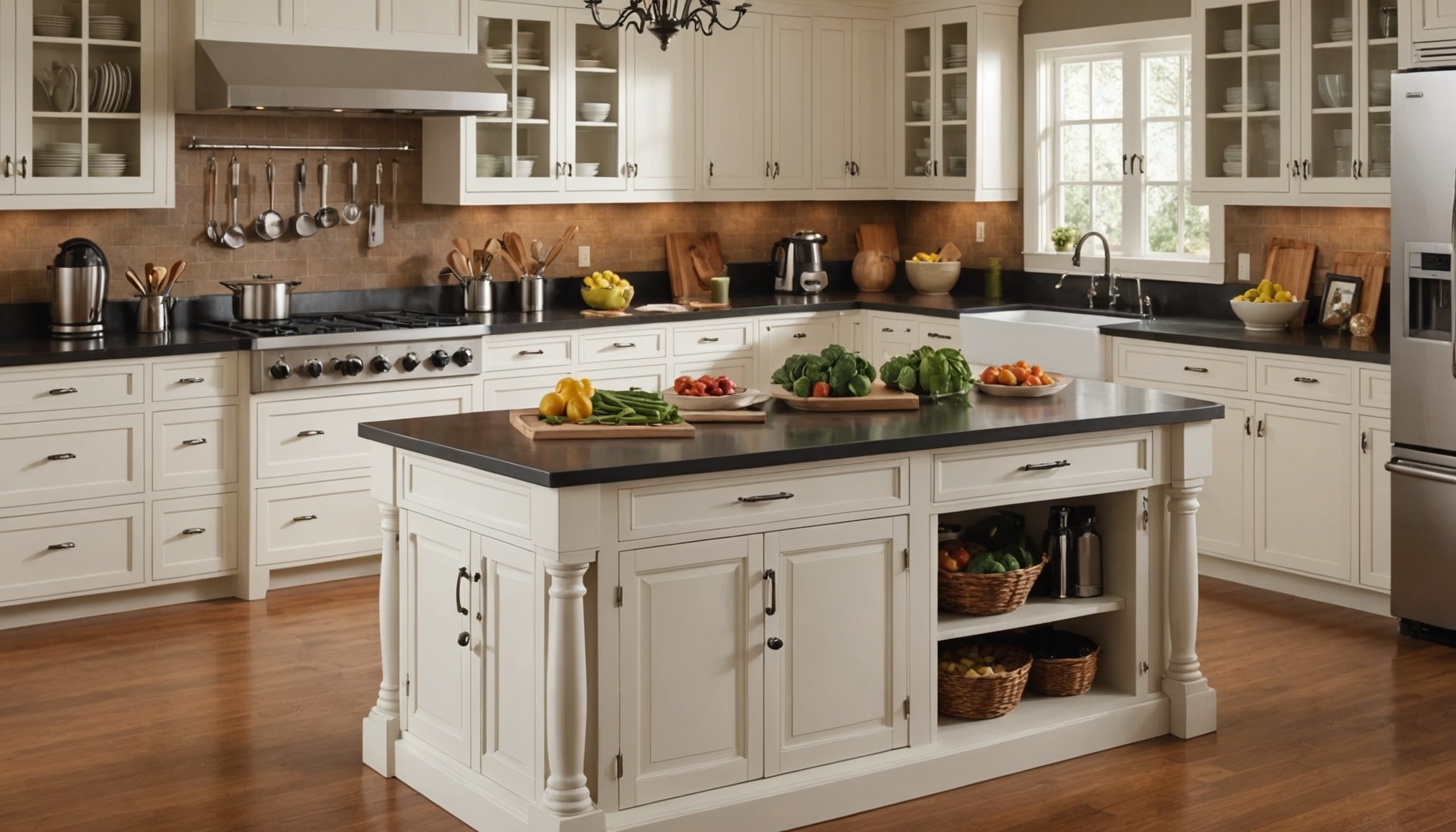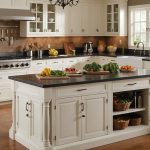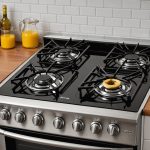Unlock the Perfect Kitchen Island Size for Effortless Healthy Meal Preparation Success
When it comes to designing a kitchen that is both functional and aesthetically pleasing, one of the most crucial elements to consider is the kitchen island. A well-designed kitchen island can transform your cooking space into an efficient and enjoyable area for meal preparation. Here’s a comprehensive guide to help you choose the perfect kitchen island size for your needs.
Understanding the Importance of Kitchen Island Size
A kitchen island is more than just an additional counter space; it is a central hub that can enhance your cooking experience. Here are a few reasons why the size of your kitchen island is so important:
Also to discover : Transform your kitchen: a comprehensive blueprint for creating an ultimate hydration hub for successful weight loss
Enhancing Functionality
A kitchen island can provide extra counter space, storage, and sometimes even seating. However, if it is too large or too small, it can disrupt the flow of your kitchen. For instance, a small kitchen island in a large kitchen might look out of place and not provide enough functionality, while an oversized island in a small kitchen can make the space feel cramped[5].
Optimizing Traffic Flow
The size of your kitchen island must be considered in relation to the overall layout of your kitchen. A general rule is to leave at least 42 inches (106.7 cm) of space between the kitchen island and other countertops to ensure smooth traffic flow[1].
Also to see : Effortless access: innovative overhead cabinet designs for your smart kitchen and healthy eating
Aesthetic Appeal
The size and design of your kitchen island can significantly impact the aesthetic of your kitchen. It should be proportionate to the overall size of the kitchen and complement the existing design elements.
Determining the Ideal Kitchen Island Size
To determine the ideal size for your kitchen island, you need to consider several factors, including the size of your kitchen, the layout, and your specific needs.
Kitchen Size and Layout
For an L-shape kitchen floor plan, which is one of the most common layouts, an island tends to work best if the kitchen dimensions are at least 10×10 feet. This ensures there is enough space to move around the island comfortably[3].
Measuring Your Space
Here are some key measurements to consider when deciding on the size of your kitchen island:
- Length and Width: The length and width of your kitchen island should be proportionate to the size of your kitchen. A common size is around 4-6 feet long and 2-3 feet wide, but this can vary based on your specific needs and space constraints[5].
- Height: The standard height for a kitchen island is typically 36 inches (91.5 cm), matching the height of the countertops to ensure comfortable food preparation[1].
- Clearance: Ensure there is at least 42 inches (106.7 cm) of clearance between the kitchen island and other countertops to maintain easy movement and access[1].
Design Considerations for Your Kitchen Island
When designing your kitchen island, several factors need to be taken into account to ensure it is both functional and visually appealing.
Storage Space
One of the primary benefits of a kitchen island is the additional storage it provides. Here are some storage options to consider:
- Drawers and Cabinets: Incorporate drawers and cabinets to store kitchen items such as utensils, cookware, and ingredients.
- Open Shelving: Adding open shelving can provide easy access to frequently used items and add a decorative element to your kitchen[5].
Seating and Counter Space
If you plan to include seating with your kitchen island, here are some tips:
- Choose Seats that Fit: Ensure the seats you choose fit comfortably under the island. For example, barstools fit underneath 42- to 46-inch-high breakfast bars, allowing at least 12 inches of clear knee space[2].
- Counter Space: Ensure the counter space on your island is sufficient for food preparation. A standard depth for countertops is 24 inches (61 cm), which accommodates most kitchen tasks[1].
Practical Tips for Choosing the Right Kitchen Island
Here are some practical tips to help you choose the right kitchen island for your space:
Assess Your Needs
- Meal Prep: Consider how you will use the island for meal preparation. If you need a lot of counter space, ensure the island is large enough to accommodate this.
- Storage: Think about the items you need to store. If you have a lot of cookware or utensils, you may need more storage space.
Consider the Materials
- Durability: Choose materials that are durable and easy to clean, such as granite or stainless steel.
- Aesthetic: Select materials that complement the existing design elements in your kitchen.
Optimize the Layout
- Assembly Line: Design your kitchen island to follow the assembly line principle, where each station (prep, cook, serve) is logically placed to enhance efficiency.
- Traffic Flow: Ensure the island does not obstruct the traffic flow in your kitchen. Leave enough space around the island for easy movement.
Examples and Case Studies
Let’s look at a few examples to illustrate how different kitchen island sizes and designs can work in various kitchen layouts.
Small Kitchen
In a small kitchen, a compact island can be very effective. For example, a 3×2 feet island with built-in storage and a small breakfast bar can provide additional counter space and seating without overwhelming the space.
Large Kitchen
In a larger kitchen, you can opt for a more substantial island. A 6×3 feet island with ample storage, a large counter space, and seating for four can be a central hub for meal preparation and socializing.
Comparative Table: Kitchen Island Sizes and Features
Here is a comparative table to help you visualize different kitchen island sizes and their features:
| Island Size | Length x Width | Height | Storage Options | Seating Capacity | Clearance Needed |
|---|---|---|---|---|---|
| Small | 3×2 feet | 36 inches | Drawers, cabinets | 2 barstools | 42 inches |
| Medium | 4×3 feet | 36 inches | Drawers, cabinets, open shelving | 3 barstools | 42 inches |
| Large | 6×3 feet | 36 inches | Drawers, cabinets, open shelving | 4 barstools | 42 inches |
Quotes and Insights from Experts
Here are some insights from experts in kitchen design:
- “A kitchen island should be proportionate to the overall size of the kitchen. An oversized island can make the space feel cramped, while a small island might not provide enough functionality,” says a kitchen design expert[5].
- “When designing a kitchen island, it’s crucial to consider the traffic flow and ensure there is enough clearance around the island for easy movement,” advises another expert[1].
Frequently Asked Questions
Here are some frequently asked questions about choosing the right kitchen island size:
Q: What is the minimum clearance needed between the kitchen island and other countertops?
A: The minimum clearance needed is at least 42 inches (106.7 cm) to ensure smooth traffic flow[1].
Q: How do I determine the ideal size for my kitchen island?
A: Consider the size of your kitchen, the layout, and your specific needs. Ensure the island is proportionate to the overall size of the kitchen and leaves enough space for movement[5].
Q: What are some common storage options for a kitchen island?
A: Common storage options include drawers, cabinets, and open shelving. These can be tailored to your specific needs and the items you need to store[5].
Choosing the perfect kitchen island size is a critical step in creating a functional and efficient cooking space. By considering the size of your kitchen, the layout, and your specific needs, you can design an island that enhances your meal preparation experience. Remember to optimize the layout for traffic flow, incorporate adequate storage, and select materials that are both durable and aesthetically pleasing. With the right kitchen island, you can transform your kitchen into a culinary haven that makes healthy meal preparation a joy.











